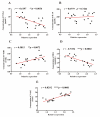A Pilot Study of the Effect of Lactobacillus casei Obtained from Long-Lived Elderly on Blood Biochemical, Oxidative, and Inflammatory Markers, and on Gut Microbiota in Young Volunteers
- PMID: 34836153
- PMCID: PMC8622130
- DOI: 10.3390/nu13113891
A Pilot Study of the Effect of Lactobacillus casei Obtained from Long-Lived Elderly on Blood Biochemical, Oxidative, and Inflammatory Markers, and on Gut Microbiota in Young Volunteers
Abstract
Probiotic intake has been shown to improve certain physiological health indicators. We aimed to examine effects of Lactobacillus casei LTL1879, obtained from long-lived elderly volunteers, on blood biochemical, oxidative, and inflammatory markers and gut microbiota in twenty healthy, young volunteers. Volunteers were randomly divided into equal probiotic and placebo groups and changes in blood biochemical indicators, oxidative and inflammatory markers, and gut microbiota were examined after three weeks of probiotic intervention. The probiotic group's antioxidant levels were significantly enhanced post-intervention. Total antioxidant capacity (T-AOC) levels were significantly increased (p < 0.0001), while malondialdehyde (MDA) levels decreased (p < 0.05), and total superoxide dismutase (T-SOD) levels increased, but with no significant difference. In addition, Interleukin-10 (IL-10) and tumor necrosis factor-α (TNF-α) levels were significantly up-regulated and down-regulated (p < 0.05, respectively). Escherichia coli, Enterococcus, and Bacteroides expression was significantly reduced (p < 0.05), while Clostridium leptum, Bifidobacterium, and Lactobacillus expression increased (p < 0.05). Volunteer health status was quantified using principal components and cluster analysis, indicating that the probiotic group's overall score was higher than that of the placebo group. The results of this pilot study suggest L. casei LTL 1879 can significantly improve specific immune, oxidative, and gut microbiota characteristics related to health factors.
Keywords: Lactobacillus casei LTL1879; blood biochemical; gut microbiota; healthy young people; inflammation; oxidant; probiotics.
Conflict of interest statement
The authors declare no conflict of interest.
Figures





References
Publication types
MeSH terms
Substances
Grants and funding
LinkOut - more resources
Full Text Sources

